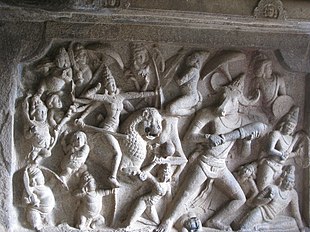Mahishasura

Mahishasura ( Sanskrit : महिषासुर mahiṣāsura , from mahisha , "buffalo" and asura , "demon") is the name of a powerful demon in Indian mythology; he died fighting the goddess Durga in her guise as a buffalo demon slayer Mahishasura Mardini. The legend is known throughout India and is frequently depicted.
Legend

origin
Rambha, the father of Mahishasura, was the king of all demons. He fell in love with Princess Shyamala, who had been cursed to take the form of a water buffalo . From this relationship arose Mahishasura, who could take the form of both a human and a buffalo.
Fight against Durga
Gods ( devas ) and demons ( asuras ) were often at war; in one of the battles Rambha was killed by Indra . As Mahishasura grew older and learned of his father's fate, he gathered a band of demons around him and began to terrorize the heavenly gods. His power was so great that he could even penetrate heaven and drive all gods from there. Thereupon the gods advised what to do: Since the demon - after years of asceticism - had received the promise from Brahma that he could not be killed by any man, they created with their common energy a beautiful female being who was on a tiger ( usually represented as a lion) rides. Each god gave her a copy of one of his weapons - from Shiva she received the trident ( trishula ), from Vishnu the conch horn ( shankha ), from Kubera the club ( gada ), from Yama a shield and sword, from Indra a thunderbolt ( vajra ), etc. When Mahishasura heard of her, he immediately dispatched his army of demons; however, this was destroyed by Durga. Thereupon there was a duel between her and the demon, which lasted ten days, but finally ended with his annihilation.

presentation
In classical Indian sculpture, Mahishasura is not worthy of any single representation - only Durga's victory over Mahishasura, which appears in the form of a slain buffalo, is shown. Often, shortly before his end, he again takes on human form and asks the goddess for mercy, which she does not grant him.
Fighting scenes are also shown in the painting, with Mahishasura sometimes tripling himself and his powers. But the goddess Durga, riding a tiger, also potentiates her powers, which is reflected in the number of her arms.
symbolism
Demons (cf. also Andhaka , Hiranyakashipu , Hiranyaksha ) endanger the existing order - wanted by gods and humans. They unite in themselves all evil, d. H. destructive, selfish and ultimately stupid forces. Through their work, they remove people from a peaceful coexistence, in which values such as wisdom as well as inner balance and harmony should play a dominant role. The killing of the asura therefore represents the overcoming and the mystical death of the negative forces.
Others
The name of the south Indian city of Mysore ( Karnataka ) is said to be derived from Mahishasura; a modern statue of the demon stands outside the city on Chamundi Hill.
literature
- Anneliese and Peter Keilhauer: The Imagery of Hinduism. The Indian world of gods and their symbolism. DuMont, Cologne 1986, pp. 201ff, ISBN 3-7701-1347-0 .
- Veronica Ions: Indian Mythology. Hamlyn Publishing, London 1988, p. 89, ISBN 0-600-34285-9
Web links
- Mahishasura Mardini. Baba Rampuri, 2012
